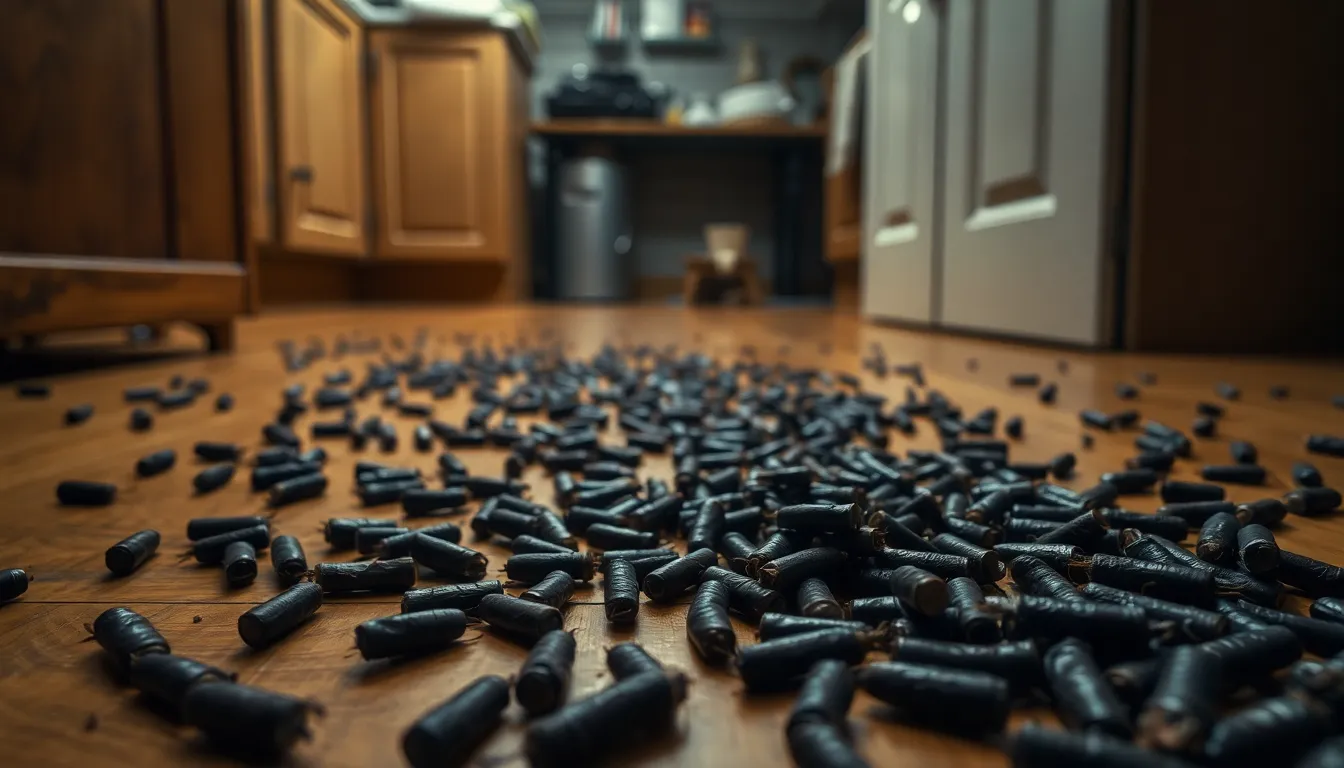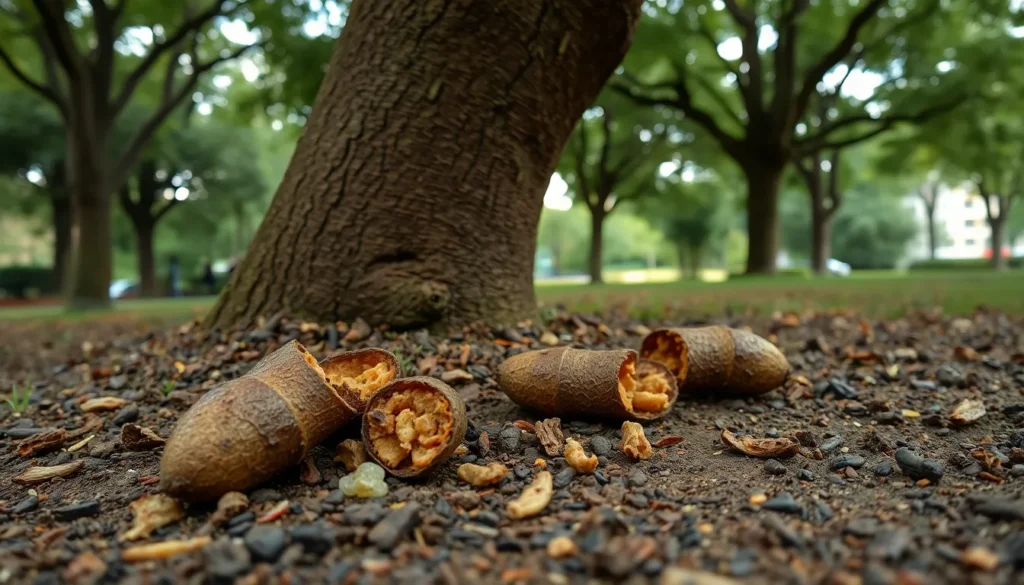Table of Contents
ToggleWhen it comes to deciphering the mysteries of nature, few things are as perplexing as distinguishing between squirrel poop and rat poop. They may seem like mere brown nuggets, but spotting the difference can save you from an unwelcome rodent roommate. Who knew that a little scat could lead to such big revelations?
Understanding Squirrel Poop
Squirrel droppings differ from rat droppings in size, shape, and location. Recognizing these differences helps manage wildlife encounters effectively.
Characteristics of Squirrel Droppings
Squirrel feces measure about 0.25 to 0.5 inches in length, typically cylindrical and slightly curved. Color varies from dark brown to black, often appearing shiny when fresh. A rough texture accompanies the droppings, usually containing visible bits of undigested food like seeds and nuts. Shape can help distinguish them from rat droppings, which tend to be more uniform and larger. Additionally, the presence of hair in squirrel poop occurs frequently due to their diet, while the smell remains mild compared to rat droppings.
Common Locations to Find Squirrel Poop
Squirrel droppings commonly appear beneath trees and near feeding sites. Busy areas like bird feeders often collect them in significant quantities. Attics and wall voids also serve as potential locations for droppings as squirrels nest in these spaces. Parks and urban areas with dense tree coverage frequently host squirrel feces along pathways. Garden beds may reveal evidence of squirrels as they forage for food, further identifying their activities.
Identifying Rat Poop

Identifying rat droppings plays a crucial role in managing pest control. Recognizing specific features helps differentiate them from other animals like squirrels.
Features of Rat Droppings
Rat droppings typically measure 0.25 to 0.5 inches in length. They tend to be darker and shinier than squirrel feces. The shape resembles a tapered cylinder, often with pointed ends. Rat droppings may also appear smoother and less textured. Unlike squirrel feces, rat droppings frequently contain no visible food debris. An average rat produces around 20 to 50 droppings daily, indicating a high activity level.
Typical Places Where Rat Poop Is Found
Common locations for rat droppings include kitchens, basements, and attics. They often appear in hidden areas like behind appliances or beneath sinks. Outdoors, rats leave droppings near garbage piles, compost bins, or garden beds. Areas with dense vegetation or debris, such as rodent burrows, also show droppings. Recognizing these locations aids in effectively addressing potential infestations.
Squirrel Poop Vs Rat Poop Pictures
Understanding the visual differences between squirrel and rat droppings aids identification. Observing these distinctions makes recognizing wildlife encounters straightforward.
Visual Comparison of Both Types
Squirrel feces typically appear as cylindrical pellets measuring 0.25 to 0.5 inches long. Colors range from dark brown to black and often exhibit a rough texture. In contrast, rat droppings exhibit a darker, shinier appearance and are shaped like tapered cylinders with pointed ends. Both types measure similarly in length, yet their textures and finishes differ, providing clear visual cues. Squirrel droppings may show undigested food particles, while rat droppings maintain a smooth surface. Spotting these differences in images serves as a simple reference for effective identification.
Key Differences Highlighted in Images
Images of squirrel droppings reveal a rougher texture, indicating their organic diet with visible food debris. Rat droppings, on the other hand, are primarily smooth, lacking any noticeable food bits. Squirrel pellets curve slightly, while rat droppings present a more uniform shape. Knowing these differences proves essential; squirrels leave droppings near feeding areas, while rats often deposit them in hidden or high-traffic locales. Utilizing visual comparisons aids in discerning the two and responding appropriately based on the specific animal behaviors and habitat choices evident in the feces.
The Importance of Identification
Accurate identification of squirrel and rat droppings plays a crucial role in managing wildlife encounters. Misidentifying these feces can lead to significant consequences.
Why Accurate Identification Matters
Understanding the differences between squirrel and rat droppings aids in effective pest control strategies. Misidentification may result in inadequate responses to wildlife presence. Recognizing squirrels versus rats helps determine appropriate exclusion methods, reducing the risk of infestations. It also influences the selection of bait and traps used to address specific animals. Knowing where droppings appear offers insights into the behaviors and habitats of these creatures. The right identification allows for targeted actions, making wildlife management more efficient.
Health Risks Associated with Misidentification
Health risks increase when identifying droppings incorrectly. Rat feces can harbor pathogens like hantavirus, which poses serious health threats. Misidentifying squirrel droppings as rat droppings may lead to unnecessary exposure to harmful bacteria and diseases. Inadequate sanitation practices may arise from confusion between the two, compounding health risks in human environments. Individuals may also overlook necessary cleaning procedures for the more dangerous rat droppings. Correctly identifying droppings contributes to maintaining safe living spaces and promoting public health awareness.
Identifying the differences between squirrel and rat droppings is essential for effective wildlife management. Recognizing the unique characteristics of each type of feces can prevent potential infestations and health risks. Squirrel droppings, with their rough texture and visible food particles, differ significantly from the smoother, shinier rat droppings.
By understanding these distinctions, homeowners can take appropriate measures to maintain a safe environment. Proper identification not only aids in pest control strategies but also promotes public health awareness. Ultimately, the ability to discern between these droppings empowers individuals to manage wildlife encounters more effectively.







